英语高一必修二unit1知识点总结
- 格式:docx
- 大小:37.23 KB
- 文档页数:4
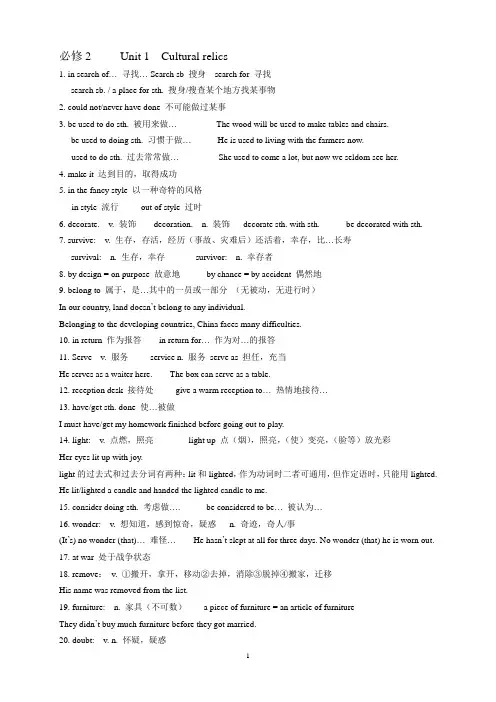
必修2 Unit 1 Cultural relics1. in search of…寻找… Search sb 搜身search for 寻找search sb. / a place for sth. 搜身/搜查某个地方找某事物2. could not/never have done 不可能做过某事3. be used to do sth. 被用来做…The wood will be used to make tables and chairs.be used to doing sth. 习惯于做…He is used to living with the farmers now.used to do sth. 过去常常做…She used to come a lot, but now we seldom see her.4. make it 达到目的,取得成功5. in the fancy style 以一种奇特的风格in style 流行out of style 过时6. decorate. v. 装饰decoration. n. 装饰decorate sth. with sth. be decorated with sth.7. survive: v. 生存,存活,经历(事故、灾难后)还活着,幸存,比…长寿survival: n. 生存,幸存survivor: n. 幸存者8. by design = on purpose 故意地by chance = by accident 偶然地9. belong to 属于,是…其中的一员或一部分(无被动,无进行时)In our country, land doesn’t belong to any individual.Belonging to the developing countries, China faces many difficulties.10. in return 作为报答in return for…作为对…的报答11. Serve v. 服务service n. 服务serve as 担任,充当He serves as a waiter here. The box can serve as a table.12. reception desk 接待处give a warm reception to…热情地接待…13. have/get sth. done 使…被做I must have/get my homework finished before going out to play.14. light: v. 点燃,照亮light up 点(烟),照亮,(使)变亮,(脸等)放光彩Her eyes lit up with joy.light的过去式和过去分词有两种:lit和lighted,作为动词时二者可通用,但作定语时,只能用lighted. He lit/lighted a candle and handed the lighted candle to me.15. consider doing sth. 考虑做…. be considered to be…被认为…16. wonder: v. 想知道,感到惊奇,疑惑n. 奇迹,奇人/事(It’s) no wonder (that)…难怪…He hasn’t slept at all for three days. No wonder (that) he is worn out.17. at war 处于战争状态18. remove:v. ①搬开,拿开,移动②去掉,消除③脱掉④搬家,迁移His name was removed from the list.19. furniture: n. 家具(不可数) a piece of furniture = an article of furnitureThey didn’t buy much furniture before they got married.20. doubt: v. n. 怀疑,疑惑动词doubt在肯定句中,后跟if/whether引导的宾语从句,在否定句/疑问句中后跟that引导的宾语从句。
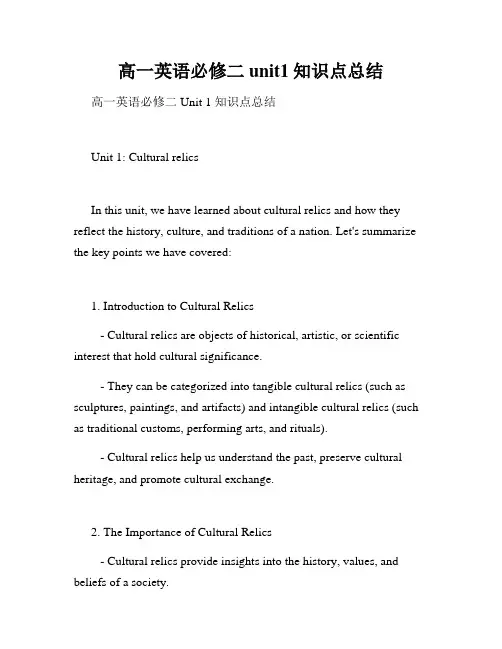
高一英语必修二unit1知识点总结高一英语必修二 Unit 1 知识点总结Unit 1: Cultural relicsIn this unit, we have learned about cultural relics and how they reflect the history, culture, and traditions of a nation. Let's summarize the key points we have covered:1. Introduction to Cultural Relics- Cultural relics are objects of historical, artistic, or scientific interest that hold cultural significance.- They can be categorized into tangible cultural relics (such as sculptures, paintings, and artifacts) and intangible cultural relics (such as traditional customs, performing arts, and rituals).- Cultural relics help us understand the past, preserve cultural heritage, and promote cultural exchange.2. The Importance of Cultural Relics- Cultural relics provide insights into the history, values, and beliefs of a society.- They contribute to the development of national identity and pride.- Cultural relics attract tourists, boost the economy, and promote cultural tourism.3. Protection of Cultural Relics- The preservation and protection of cultural relics are essential to maintain our cultural heritage.- Governments and organizations play a crucial role in safeguarding cultural relics through legislation and conservation efforts.- Individuals can also contribute by raising awareness, participating in restoration projects, and respecting cultural relics.4. Famous Cultural Relics in China- The Great Wall: An iconic symbol of Chinese civilization and a UNESCO World Heritage Site.- The Terracotta Army: Discovered in the mausoleum of Emperor Qin Shi Huang, it represents the military might of ancient China.- The Forbidden City: Located in Beijing, it served as the imperial palace for 24 emperors during the Ming and Qing dynasties.- The Mogao Caves: Situated along the Silk Road, these caves house a collection of Buddhist art and scriptures.5. Cultural Relics Around the World- The Pyramids of Egypt: Constructed as tombs for pharaohs, they showcase ancient Egyptian civilization.- The Acropolis of Athens: A group of historical buildings including the famous Parthenon, representing ancient Greek culture.- Stonehenge: A prehistoric monument in England that raises questions about its purpose and construction.6. Cultural Relics and Tourism- Cultural relics are major tourist attractions, drawing visitors from around the world.- Tourism provides financial support for the preservation and restoration of cultural relics.- It is crucial to balance tourism with the need for conservation to ensure the long-term sustainability of cultural relics.In conclusion, the study of cultural relics offers valuable insights into our shared human history and cultural diversity. By understandingand preserving these relics, we can celebrate our past, embrace our present, and inspire future generations to appreciate and protect our rich cultural heritage.。

高一英语必修二unit1知识点(经典版)编制人:__________________审核人:__________________审批人:__________________编制单位:__________________编制时间:____年____月____日序言下载提示:该文档是本店铺精心编制而成的,希望大家下载后,能够帮助大家解决实际问题。
文档下载后可定制修改,请根据实际需要进行调整和使用,谢谢!并且,本店铺为大家提供各种类型的经典范文,如演讲稿、总结报告、合同协议、方案大全、工作计划、学习计划、条据书信、致辞讲话、教学资料、作文大全、其他范文等等,想了解不同范文格式和写法,敬请关注!Download tips: This document is carefully compiled by this editor. I hope that after you download it, it can help you solve practical problems. The document can be customized and modified after downloading, please adjust and use it according to actual needs, thank you!In addition, this shop provides you with various types of classic sample essays, such as speech drafts, summary reports, contract agreements, project plans, work plans, study plans, letter letters, speeches, teaching materials, essays, other sample essays, etc. Want to know the format and writing of different sample essays, so stay tuned!高一英语必修二unit1知识点如果说阻止他人获取知识就是扼杀知识,那么对扼杀知识习以为常,就会导致对杀害人习以为常——因为确切而言,人就是知识;还会导致对人的缺失习以为常。
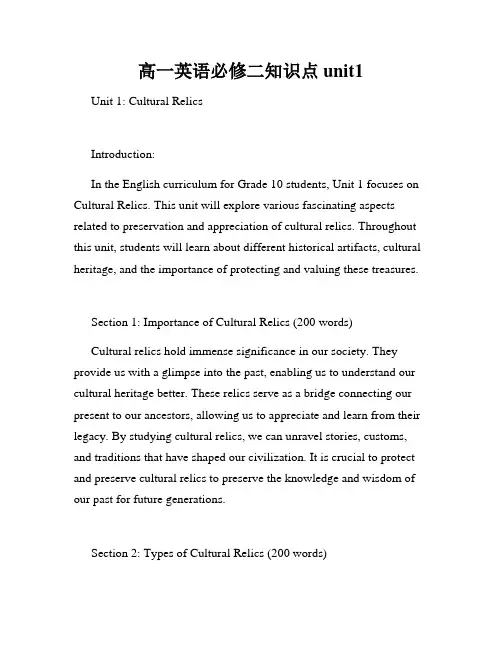
高一英语必修二知识点unit1 Unit 1: Cultural RelicsIntroduction:In the English curriculum for Grade 10 students, Unit 1 focuses on Cultural Relics. This unit will explore various fascinating aspects related to preservation and appreciation of cultural relics. Throughout this unit, students will learn about different historical artifacts, cultural heritage, and the importance of protecting and valuing these treasures.Section 1: Importance of Cultural Relics (200 words)Cultural relics hold immense significance in our society. They provide us with a glimpse into the past, enabling us to understand our cultural heritage better. These relics serve as a bridge connecting our present to our ancestors, allowing us to appreciate and learn from their legacy. By studying cultural relics, we can unravel stories, customs, and traditions that have shaped our civilization. It is crucial to protect and preserve cultural relics to preserve the knowledge and wisdom of our past for future generations.Section 2: Types of Cultural Relics (200 words)Cultural relics come in various forms, each with its unique historical and cultural value. One common type is archaeological artifacts such as pottery, tools, and weapons, which reveal insights into ancient civilizations. Another type includes historical documents, such as manuscripts and scrolls, providing written evidence of significant events and ideologies. Architectural structures, such as temples, palaces, and historical buildings, are also considered cultural relics, showcasing architectural styles and cultural practices. Lastly, artwork, including paintings, sculptures, and carvings, serves as a visual representation of artistic expression and cultural aesthetics.Section 3: Preservation and Protection of Cultural Relics (300 words)The preservation and protection of cultural relics are of utmost importance. Proper conservation techniques are required to prevent deterioration and ensure the longevity of these valuable artifacts. Museums and heritage sites play a crucial role in safeguarding and exhibiting cultural relics, allowing the public to learn, appreciate, and respect their historical significance. Additionally, international collaboration and agreements help prevent the illegal trafficking of cultural relics, ensuring their return to their rightful places.Section 4: Cultural Relics in China (200 words)China is renowned for its rich cultural heritage and numerous cultural relics. The Great Wall, an iconic symbol of Chinese civilization, spans thousands of kilometers and attracts millions of visitors each year. The Terracotta Army, discovered in Xi'an, showcases the remarkable artistic and military achievements of the ancient Chinese. The Forbidden City in Beijing, with its majestic palaces and halls, reflects the grandeur of the Ming and Qing dynasties. These cultural relics highlight China's illustrious history, providing a glimpse into its vibrant past.Section 5: Cultural Relics: A Source of Inspiration (100 words)Cultural relics serve as a source of inspiration for artists, writers, and filmmakers. They provide a wealth of material for creative works, be it historical novels, epic movies, or artworks. The stories and legends surrounding these relics ignite imagination and creativity, allowing artists to bring history to life for contemporary audiences.Conclusion:The study of cultural relics in Unit 1 offers students an opportunity to delve into the rich tapestry of human history and cultural diversity. By acknowledging the importance of cultural relics and understanding the need for their preservation, students can develop a deeperappreciation for their own heritage and contribute to the safeguarding of cultural treasures for generations to come.。
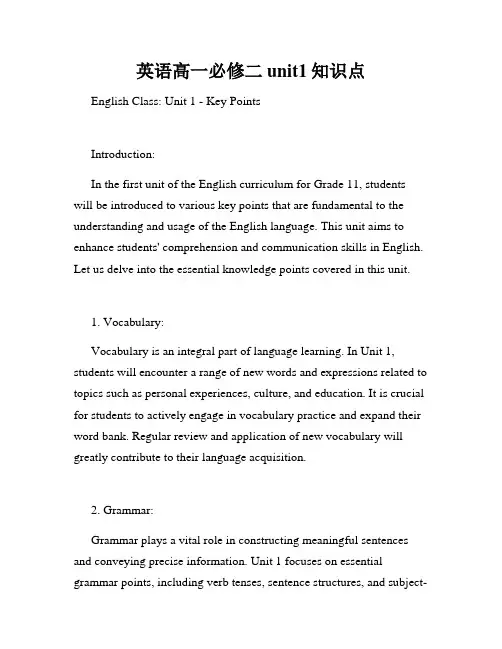
英语高一必修二unit1知识点English Class: Unit 1 - Key PointsIntroduction:In the first unit of the English curriculum for Grade 11, students will be introduced to various key points that are fundamental to the understanding and usage of the English language. This unit aims to enhance students' comprehension and communication skills in English. Let us delve into the essential knowledge points covered in this unit.1. Vocabulary:Vocabulary is an integral part of language learning. In Unit 1, students will encounter a range of new words and expressions related to topics such as personal experiences, culture, and education. It is crucial for students to actively engage in vocabulary practice and expand their word bank. Regular review and application of new vocabulary will greatly contribute to their language acquisition.2. Grammar:Grammar plays a vital role in constructing meaningful sentences and conveying precise information. Unit 1 focuses on essential grammar points, including verb tenses, sentence structures, and subject-verb agreement. Students will learn how to use these grammar rules effectively to express themselves accurately and fluently. Consistent practice is essential for mastering grammar concepts.3. Reading Comprehension:Improving reading comprehension is crucial for understanding written texts and extracting information effectively. Throughout Unit 1, students will engage with a variety of reading materials, such as articles, essays, and stories. They will develop essential reading skills, including skimming, scanning, and inferring, to comprehend the main ideas and details of the texts. Additionally, students will learn how to analyze and interpret the texts critically.4. Writing Skills:Effective writing skills are essential for clear and concise communication. In Unit 1, students will learn various writing techniques, such as organizing ideas, developing paragraphs, and using coherent transitions. They will also practice different types of writing, including personal narratives, descriptive essays, and argumentative pieces. Through consistent writing practice, students will enhance their ability to express their thoughts accurately and creatively.5. Listening and Speaking:Language proficiency also involves effective listening and speaking skills. Unit 1 aims to improve students' listening comprehension and oral communication abilities. Students will engage in various listening activities, such as listening to conversations, interviews, and presentations. This allows them to develop their skills in understanding spoken English and extracting information accurately. Furthermore, students will have opportunities to engage in class discussions, presentations, and debates to enhance their speaking skills and build confidence in expressing their ideas.Conclusion:The key points covered in Unit 1 of the Grade 11 English curriculum are designed to provide students with a strong foundation in vocabulary, grammar, reading comprehension, writing skills, listening, and speaking. It is essential for students to actively participate in class activities, practice regularly, and apply these key points in their daily language use. By doing so, students will develop their English language proficiency and become effective communicators in both academic and real-world contexts.。
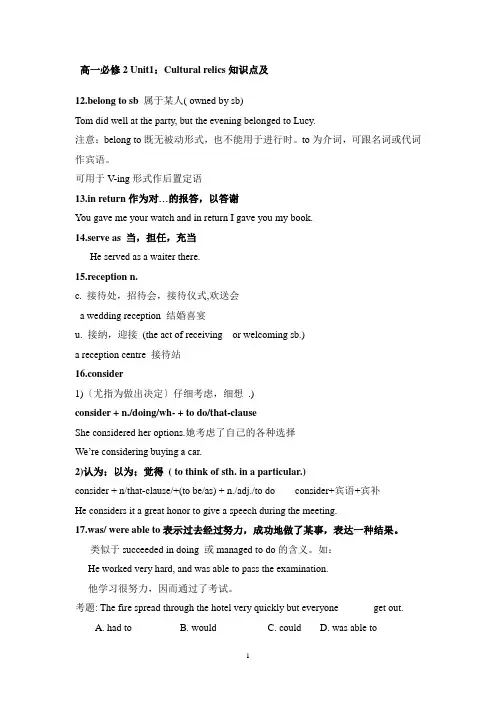
高一必修2 Unit1:Cultural relics知识点及12.belong to sb 属于某人( owned by sb)Tom did well at the party, but the evening belonged to Lucy.注意:belong to既无被动形式,也不能用于进行时。
to为介词,可跟名词或代词作宾语。
可用于V-ing形式作后置定语13.in return作为对…的报答,以答谢You gave me your watch and in return I gave you my book.14.serve as 当,担任,充当He served as a waiter there.15.reception n.c. 接待处,招待会,接待仪式,欢送会a wedding reception 结婚喜宴u. 接纳,迎接(the act of receiving or welcoming sb.)a reception centre 接待站16.consider1)〔尤指为做出决定〕仔细考虑,细想.)consider + n./doing/wh- + to do/that-clauseShe considered her options.她考虑了自己的各种选择We’re considering buying a car.2)认为;以为;觉得( to think of sth. in a particular.)consider + n/that-clause/+(to be/as) + n./adj./to do consider+宾语+宾补He considers it a great honor to give a speech during the meeting.17.was/ were able to 表示过去经过努力,成功地做了某事,表达一种结果。
类似于succeeded in doing 或managed to do的含义。
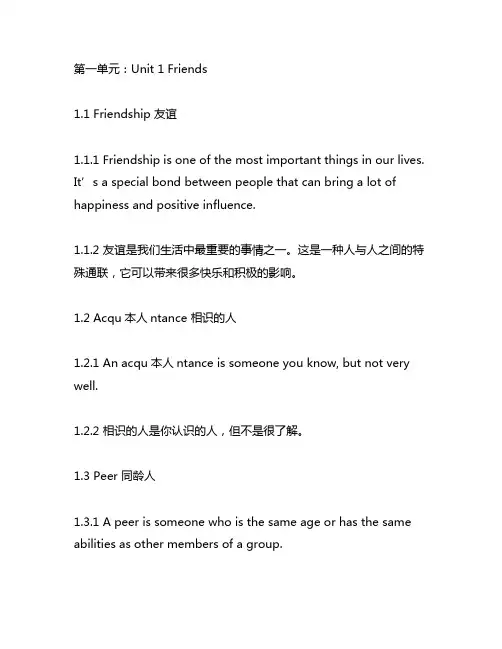
第一单元:Unit 1 Friends1.1 Friendship 友谊1.1.1 Friendship is one of the most important things in our lives. It’s a special bond between people that can bring a lot of happiness and positive influence.1.1.2 友谊是我们生活中最重要的事情之一。
这是一种人与人之间的特殊通联,它可以带来很多快乐和积极的影响。
1.2 Acqu本人ntance 相识的人1.2.1 An acqu本人ntance is someone you know, but not very well.1.2.2 相识的人是你认识的人,但不是很了解。
1.3 Peer 同龄人1.3.1 A peer is someone who is the same age or has the same abilities as other members of a group.1.3.2 同龄人是和你同龄或具有相同能力的人。
1.4 Mate 伙伴1.4.1 A mate is a friend or apanion, especially a male friend.1.4.2 伙伴指的是朋友或伴侣,尤其是男性朋友。
1.5 Confide 吐露秘密1.5.1 To confide is to tell someone secrets or private feelings, usually because you trust them.1.5.2 吐露秘密是指告诉别人秘密或私人感情,通常是因为你信任他们。
1.6 Get along 和睦相处1.6.1 To get along means to have a friendly relationship with someone.1.6.2 和睦相处意味着和某人有着友好的关系。
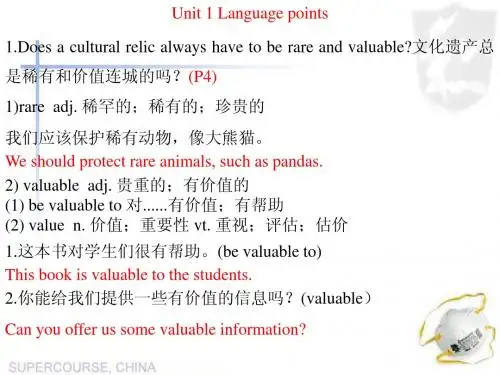
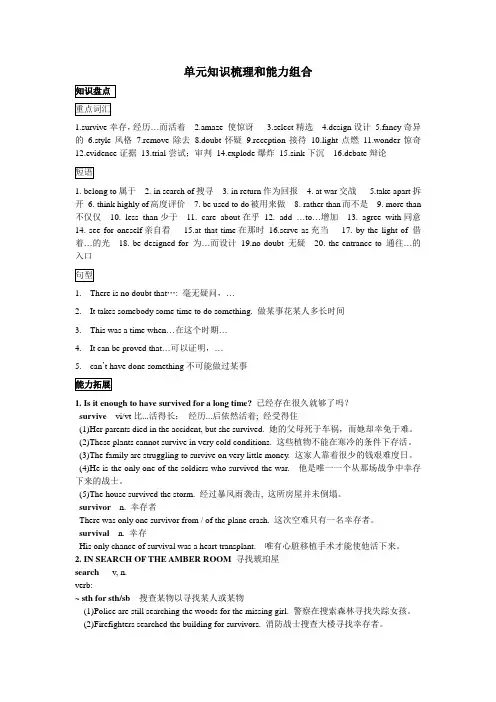
单元知识梳理和能力组合1.survive幸存,经历…而活着2.amaze 使惊讶3.select精选4.design设计5.fancy奇异的6.style风格7.remove除去8.doubt怀疑9.reception接待10.light点燃11.wonder惊奇12.evidence证据13.trial尝试;审判14.explode爆炸15.sink下沉16.debate辩论1. belong to属于2. in search of搜寻3. in return作为回报4. at war交战5.take apart拆开6. think highly of高度评价7. be used to do被用来做8. rather than而不是9. more than 不仅仅10. less than少于11. care about在乎12. add …to…增加13. agree with同意14. see for oneself亲自看15.at that time在那时16.serve as充当17. by the light of 借着…的光18. be designed for 为…而设计19.no doubt 无疑20. the entrance to 通往…的入口1.There is no doubt that…: 毫无疑问,…2.It takes somebody some time to do something. 做某事花某人多长时间3.This was a time when…在这个时期…4.It can be proved that…可以证明,…5.can’t have done something不可能做过某事1.Is it enough to have survived for a long time? 已经存在很久就够了吗?survive vi/vt比...活得长;经历...后依然活着; 经受得住(1)Her parents died in the accident, but she survived. 她的父母死于车祸,而她却幸免于难。

必修二Unit 11.culture 文化---cultural 文化的cultural relics 文化遗产cultural traditions 文化传统Many unearthed cultural relics were exhibited at the museum.博物馆展出了许多出土文物。
The capital is the political and cultural center of a country.首都是一个国家的政治文化中心。
2. relic 遗物;遗迹;纪念物relics of an ancient city古城遗迹3. rare 稀罕的;稀有的;贵重的---rarely 极少地a rare book 珍本It is rare to find such a genius nowadays.这样的天才现在很少见。
4. valuable 贵重的;有价值的value (n)价值(+s)价值观贵重物品(v)尊重珍惜valueless 无价值的invaluable=priceless 无价的valuable= be of valuerare and valuable 珍贵稀有的The flaw in this vase makes it less valuable. 这个花瓶因为有点缺陷,不那么值钱了。
4. survive (v)幸免于;幸存;生还survival (n) 幸存survivor(n) 幸存者survive from..从..存活下来,流传下来A surviveB (by..) A比B活得长He survived the war, he wanted to go home.他在战争中幸存了下来,只想回家。
5. vase 花瓶He dug out a valuable vase and handed in the country.他挖出个珍贵花瓶并把它上交给国家。
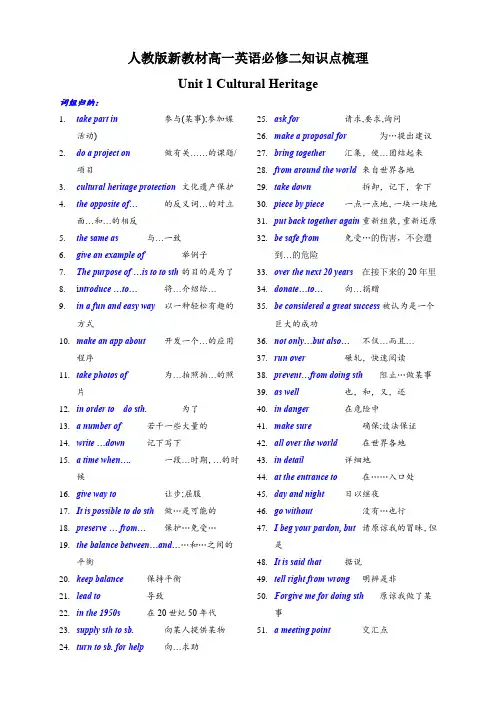
人教版新教材高一英语必修二知识点梳理Unit 1 Cultural Heritage词组归纳:1.take part in参与(某事);参加媒活动)2.do a project on 做有关……的课题/项目3.cultural heritage protection文化遗产保护4.the opposite of…的反义词…的对立面…和…的相反5.the same as 与…一致6.give an example of 举例子7.The purpose of …is to to sth的目的是为了8.i ntroduce …to…将…介绍给…9.in a fun and easy way以一种轻松有趣的方式10.make an app about开发一个…的应用程序11.take photos of 为…拍照拍…的照片12.in order to do sth.为了13. a number of 若干一些大量的14.write …down记下写下15. a time when….一段…时期,…的时候16.give way to让步;屈服17.It is possible to do sth 做…是可能的18.preserve … from…保护…免受…19.the balance between…and……和…之间的平衡20.keep balance保持平衡21.lead to导致22.in the 1950s在20世纪50年代23.supply sth to sb.向某人提供某物24.turn to sb. for help向…求助25.ask for请求,要求,询问26.make a proposal for为…提出建议27.bring together汇集,使…团结起来28.from around the world来自世界各地29.take down拆卸,记下,拿下30.piece by piece一点一点地,一块一块地31.put back together again重新组装,重新还原32.be safe from免受…的伤害,不会遭到…的危险33.over the next 20 years在接下来的20年里34.donate…to…向…捐赠35.be considered a great success被认为是一个巨大的成功36.not only…but also…不仅…而且…37.run over碾轧,快速阅读38.prevent…from doing sth阻止…做某事39.as well也,和,又,还40.in danger在危险中41.make sure确保;设法保证42.all over the world在世界各地43.in detail详细地44.at the entrance to在……入口处45.day and night日以继夜46.go without没有…也行47.I beg your pardon, but请原谅我的冒昧,但是48.It is said that据说49.tell right from wrong明辨是非50.Forgive me for doing sth原谅我做了某事51. a meeting point交汇点52.work on致力于,作用于,继续工作53.show…to the public向公众展示54.raise money集资;筹款;募捐55.get one’s attention引起…注意56.end with以…结尾/束57.neither … nor…既不…也不st forever永远持续万古长青59.keep a balance between…and…保持…和…之间的平衡60.be more likely to do sth.更有可能做某事e up with提出;想出;赶上62.donate money to…把钱捐给63.get sb. interested in sth使某人对某事感兴趣64.kind of 有点儿,有几分65.be familiar with熟悉精通清楚地了解66.speed up 加速;使加速67.take part in 参加,参与68.fall into ruins变成废墟重点单词讲解1. promote vt. 促进;提升;推销;晋级(1) promote sb. (from sth.) to sth. 把某人(从某职位)提升到某职位(2) promotion n. 提升;晋级;促进get / win promotion 获得晋级e.g. ①They discussed how to promote cooperation between the two countries. 他们讨论如何促进两国间的合作。
Unit1 Cultural relicsIN SEARCH OF THE AMBER ROOMFrederick William I, the King of Prussia, could never have imagined【1.插入语; 2.that 引导的宾从;3.such (a/an)与so 的区别】This gift was the Amber Room, which was given this name because several tons of amber were used to make it.【1.which 引导的非限制性定从;2.被动语态;3.because 引导原因状从】【which 定从】It was also a treasure decorated with gold and jewels, which took the country's best artists about ten years to make.【1.过去分词作后置定语,有被动含义;2.with 介短作后置定;3.which 非限制性定从,指代前面的整句话;4.take 花费(take sb about+时间+to do 花费某人大约多长时间去...)】 In fact, the room was not made to be a gift.It was designed for the palace of Frederick I.However, the next King of Prussia, Frederick William I, to whom the amber room belonged , decided not to keep it.【介词+引导词引导定从;belong to 属于】In 1716 he gave it to Peter the Great.In return, the Czar sent him a troop of his best soldiers.【in return 作为回报;a troop of 一群;send 送(send sb sth 送给某人某物)】So the Amber Room became part of the Czar's winter palace in St Petersburg.【疑问:为什么part 之间不加冠词a ?】About four meters long, the room served as a small reception hall for important visitors.【as 作为;for 为了】【1.疑问:不知道moved 是应该作为后置定语使用,还是应该看出过去完成时had done ;2.where 引导定从;3.spend 花费(几种花费的表达)】She told her artists to add more details to it.【第一个to 是不定式,第二个to 是介词】In 1770 the room was completed the way she wanted .【省略引导词that 的定从】Almost six hundred candles lit the room, and its mirrors and pictures shone like gold.【light-lit-lit 点亮;shine-shone-shone 发光,反光】Sadly, although the Amber Room was considered is now missing .【consider v.考虑,认为;wonder v.想知道 n.奇迹,能人 adj.极好的,神奇的】In September 1941, the Nazi army was near St Petersburg.This was a time when the two countries were at war.Before the Nazis could get to the summer palace, the Russians were able to remove some furniture and small art objects from the Amber Room.【before时间状从】However, some of the Nazis secretly stole the room itself.In less than two days 100,000 pieces (amber) were put inside twenty-seven wooden boxes.【in less than two days在至少两天内】There is no doubt that the boxes were then put on a train for Konigsberg, which was at that time a【there be句型的高级应用;that引导宾从;which引导非限制性定从】After that, what happened to the Amber Room remains a mystery.【what引导的主从】Recently, the Russians and Germans have built a new Amber Room at the summer palace.By studying old photos of the former Amber Room, they have made the new one look like the old one.【by通过(其它用法);疑问:look like...这句话是否是省略了引导词的定从?】In 2003 it was ready for the people of St Petersburg when they【for对...而言;when引导时间状从】A FACT OR AN OPINION?What is a fact? Is it something that people believe?【that引导定从】No. A fact isFor example, itis a fact.【情态动词的被动;that引导主从,it为形主】Then what is an opinion? An opinion is what someone believes is true but has not been proved.【what引导表从;现在完成时的被动】So an opinion is not good evidence in a trial.【try + -al = trial试验的,审讯的】For example, it is an opinion if you say“Cats are better pets than dogs”.【if引导条件状从】It may be true, but it is difficult to prove.【to do为真主,it为形主】Some people may not agree with this opinion but they also cannot prove that they are right.【that引导宾从】In a trial, a judge must decide which eyewitnesses to believe and which not to believe.【which引导宾从(引导词+to do)】The judge does not consider what each eyewitness looks like or where that person lives or works.【what和where引导宾从(高考阅读中有类似的结构)】He/she only cares about whether the eyewitness has given true information, which must be facts【whether引导宾从;which引导定从;rather than而不是,宁可...也不愿...】This kind of information is called evidence.第一单元文化遗产阅读一寻找琥珀普鲁士国王腓特烈·威廉一世从未想过他送个普鲁士人民伟大的礼物会有一点如此惊奇的历史。
高一英语知识点归纳和总结必修2 第一单元一、重点短语回顾1. in search _________ 寻找,搜寻2. _______ to 属于3. in _________ 作为报答,回报4. at _________ 处于交战状态5. _______ than 少于6. be __________ doing 值得做7. add A ______ B 把A添加到B8. serve _______ 充当9. agree ______ 同意;赞成10. care _______ 关心;在乎11. rather _______ 而不是12. for _________ 亲自13. to one’s _______ 令某人吃惊的是14. think _______ of 看重;器重15. search _______ 寻找1. of2. belong3. return4. war5. less than6. worth7. to8. as9. with 10. about 11. than 12. oneself 13. to 14. highly 15. for二、课本知识点1. survive作及物动词。
1)survive 表示“幸存”“(经过……)活下来”,它后面可以直接加war,flood,fire,accident,earthquake,explosin,shipwreck(船只失事)等表示“灾难”的名词。
翻译时,可以先把survive 后的名词译成“经过……后”,然后再译“幸存下来”。
但这种用法中,survive 没有被动语态。
survive sb. by + 时间段比某人活得长……2. in search of 寻找,找寻in the search of (✗) in one’s search for = in the search for (✓)search sp.某地for sb./sth 搜查某地寻找某人某物in one’s research of (×) 3. could have done意思1:过去可能做过某事I can't imagine how he could have thought of doing such a thing。
高一英语必修二知识点归纳Unit1 Cultural relics1.in search of(介词短语)寻找search for(动词短语)2.survive vi. 幸存,生还survivor n. 幸存者3. be decorated with被用··来装饰decorate sth with sth用某物装饰某物4. belong to属于,是…的成员5. serve as 担任,充当6.in return 作为回报, 作为回馈in return for 作为…的回报7. 定语从句修饰the way的关系代词可用that / in which / 不填eg.I did it in the way that/in which you taught me.I want to know the way he told you yesterday.8.light 照亮,点亮light-lit-lit 或light-lighted-lighted9. there is no doubt that…毫无疑问……10. be worth sth. 值得…be (well) worth doing sth.很值得做…sth is worthy of being done = sth is worthy to be done it’s worthwhile doing sth = it’s worthwhile to do sth11. be at war 处于战争状态,交战12.remain vi. 留下,残留+doinglink-v. 保持,继续+adj.13.to one’s amazement 令人吃惊的是be amazed at/by 对…大为吃惊14.There is no doubt that…毫无疑问…There is some doubt whether…15.apart from除了…之外16.be doing sth when…正在做某事,这时eg.He was waiting for his friend in the park when it began to rain.17.agree with同意某人的意见agree on 就…达成一致意见agree to do sth 同意做某事18.当否定副词及含有否定词的介词短语放句首时,句子需要用部分倒装。
高一英语必修二unit1知识点高一英语必修二Unit 1 知识点高一英语必修二Unit 1主要讲述了关于Friendship(友谊)的话题。
以下是该单元的一些重要知识点。
一、词汇1. Friendship (n.) 友谊,友情Example: True friendship should be based on mutual trust and understanding.2. Compassionate (adj.) 同情的,富有同情心的Example: She is a compassionate person who always cares about others' feelings.3. Trustworthy (adj.) 值得信赖的,可靠的Example: Mark is a trustworthy friend; he always keeps his promise.4. Jealous (adj.) 嫉妒的,吃醋的Example: Mary felt jealous when she saw her best friend hanging outwith someone else.5. Confide (v.) 吐露,倾诉Example: Mary confided in her best friend about her family problems.二、语法1. Comparison of adjectives 形容词比较级与最高级的用法形容词比较级用于两者之间的比较,最高级用于三者或三者以上的比较。
Example:- My cat is smaller than yours.(比较级)- Among all the cats in the neighborhood, mine is the smallest.(最高级)2. Present perfect tense 现在完成时的用法现在完成时表示过去发生的动作对现在的影响或结果,或者过去发生的一个持续到现在的动作。
高中英语必修二Unit1语法及词汇总结一、重点语法知识:1.情态动词:表示说话人的某种语气或情绪,如可能、意愿、猜测、义务、需要等。
特征:有一定的词义,但不能单独作谓语,后面接动词原形;没有人称和数的变化( have to除外);有些情态动词有过去式例如can--could, may--might, will-would. dare-dared. have to-had to等。
要点1 be able to:(1)can与be able to都表示能力,在意义上没有区别。
但can只有现在式和过去式(could),而be able to则有更多的形式。
过去式:was/ were able to将来式: will be able to完成式: have/has been able to(2)can一般指自身具有的能力,而如果要表达将来的能力,一般要用be able to(3) be able to的过去式was/ were able to可表示在过去设法做成了某事,相当于managed to do,而could则无此意义。
要点2:dare意为胆敢,敢于,既可作情态动词,又可作实义动词.(1)dare作情态动词时,没有人称和数的变化,但有过去式dared,后接动词原形,否定式为dare not/daren't,多用于否定句或疑问句。
(2)dare作实义动词时,有时态、人称和数的变化,后接带to的不定式,否定式要在其前加do not或don't。
不定式符号to有时可以省略。
I dare say我想/我敢说…How dare you.?你怎么敢?要点3 have to表示“必须,不得不”,是由于客观情况而“必须”, have to的否定形式don't have to表示“不必”,可用于各种时态中。
◆用法辨析must与have to:must强调主观看法,只有一种形式,否定形式表示禁止。
英语高一必修二unit1知识点总结英语高一必修二 Unit 1 知识点总结
高中英语必修二 Unit 1 主要学习了有关“人与动物”的知识。
在
这个单元中,我们学习了动物的分类、特征、保护和与人类的关
系等方面的内容。
以下是对该单元的知识点进行总结。
一、动物的分类
动物按照不同的特征进行分类,常见的分类方法有脊椎动物和
无脊椎动物、冷血动物和温血动物、哺乳动物和非哺乳动物等。
1. 脊椎动物(Vertebrates):具有脊柱的动物。
如鸟类(Birds)、鱼类(Fishes)、哺乳动物(Mammals)等。
2. 无脊椎动物(Invertebrates):没有脊柱的动物。
如昆虫(Insects)、软体动物(Mollusks)、节肢动物(Arthropods)等。
二、动物的特征
不同的动物在外貌、生理特征等方面存在着差异。
以下是一些动物特征的总结:
1. 鸟类的特征:具有羽毛和嘴,可以飞行。
2. 哺乳动物的特征:具有乳腺,能够哺乳喂养幼崽。
3. 爬行动物的特征:行动呈爬行状态,如蛇、龟等。
4. 两栖动物的特征:同时能在水中和陆地上生活,如青蛙等。
5. 鱼类的特征:生活在水中,呼吸通过鳃完成。
三、动物保护
动物保护是我们应该关注和重视的问题。
以下是一些动物保护的常见方面:
1. 保护野生动物及其栖息地。
2. 防止非法捕猎、盗猎和买卖野生动物及其制品。
3. 提倡保护动物的法律法规。
四、动物与人类的关系
人与动物之间存在着密切的联系和相互依赖。
以下是一些动物与人类的关系的例子:
1. 动物是人类的食物来源之一,如牛、猪、鸡等。
2. 动物在科学研究和医学领域具有重要意义,如实验动物。
3. 动物提供给人们情感上的陪伴,如宠物。
4. 动物在生态系统中扮演着重要的角色,如传粉媒介和控制害虫等。
结语
高中英语必修二 Unit 1 知识点总结了动物的分类、特征、保护和与人类的关系等方面的内容。
通过对这些知识点的学习,我们能够更好地了解动物世界,增强对动物保护的意识,从而更好地与动物共同生活在这个地球上。
(以上为根据题目要求整理的文章内容,文章排版整洁美观,语句通顺,全文表达流畅,无影响阅读体验的问题。
)。